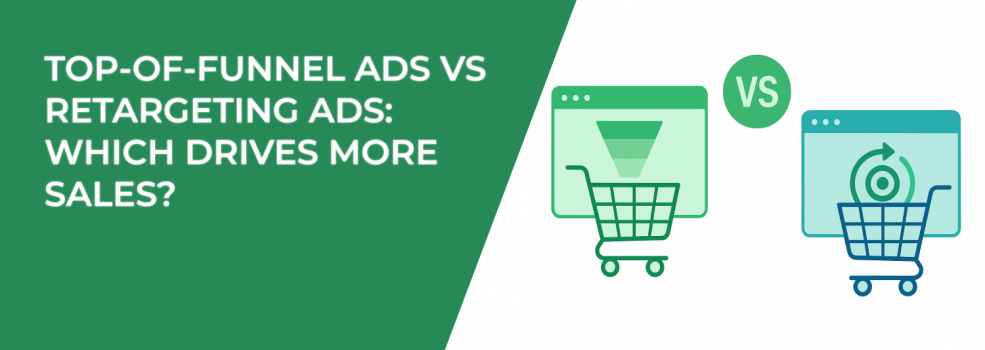Marketers often ask a deceptively simple question: should you invest more in top-of-funnel ads or retargeting ads if your goal is more sales? The truth is that both play distinct roles in the customer journey, and understanding those roles can dramatically improve your ad performance.
Let’s break it down step by step.
What Are Top-of-Funnel Ads?
Top-of-funnel (TOFU) ads target people who haven’t interacted with your brand yet. Think of them as your digital handshake. They spark awareness, generate curiosity, and introduce your brand to a wider audience.
A potential customer scrolling on Instagram might see your ad for the very first time. They might not click “Shop Now” immediately, but they stop, read, and remember. That’s the beginning of a relationship.
A few examples of TOFU campaigns include:
-
Paid social ads promoting educational content. For example, a SaaS brand could run LinkedIn ads offering a free industry report. This positions the brand as an authority while collecting leads.
-
Display ads designed to grab attention with visuals. A new DTC coffee company might use striking images of steaming mugs to build intrigue and brand recall.
-
YouTube pre-rolls showcasing your product’s story. Imagine a fitness brand showing a 15-second lifestyle clip — no hard pitch, just inspiration.
These ads rarely push for an immediate sale. Instead, they plant the seed. They create familiarity so that when your brand shows up again later, people recognize you. The challenge? They can feel expensive if you’re only measuring them by direct conversions. But without them, your retargeting audience never grows. Isn’t that worth considering?
If you’re building your first awareness campaigns, check out Meta Ad Campaign Objectives Explained: How to Choose the Right One to make sure you’re setting the right goals.
Strategy to try: Start with at least 20–30% of your paid media budget allocated to TOFU campaigns. Rotate creative every 3–4 weeks to avoid ad fatigue, and focus on value-driven content rather than discounts.
What Are Retargeting Ads?
Retargeting ads focus on people who already know you. They may have visited your website, clicked an ad, or even abandoned a shopping cart. Retargeting is about reminding and nudging — not introducing.
Think of it like a salesperson calling back a warm lead. The customer already knows who you are, and they’re interested, but they might need reassurance, an incentive, or simply a reminder to act.
Some of the best retargeting tactics include:
-
Dynamic product ads that show shoppers the exact items they viewed. A shopper who looked at a pair of sneakers yesterday might see them again today in their Facebook feed, this time paired with a five-star customer review.
-
Personalized offers for past visitors. For example, a skincare brand could retarget past visitors with “Your first order ships free” or “Get 10% off your bundle today.”
-
Sequential storytelling ads that build on earlier interactions. Someone who watched your product demo video could next see an ad featuring testimonials, then finally an ad with a time-sensitive offer.
Retargeting often produces higher click-through rates and conversions because you’re speaking to a warmer audience. But here’s the catch: without a steady flow of new people entering your funnel, retargeting eventually runs out of steam. That’s why it works best as part of a larger strategy.
If you’re new to retargeting, this step-by-step guide to setting up Facebook retargeting will help you structure campaigns that actually convert.
Strategy to try: Build segmented retargeting audiences. For example, one segment for cart abandoners (hit them with urgency-based offers), another for video viewers (show them testimonials), and another for blog readers (nurture with content-focused ads). Different intent levels deserve different ad experiences.
Which Drives More Sales?
Here’s where the nuance comes in. Top-of-funnel ads build the pipeline. Retargeting ads close the deal. Measuring them against each other can be misleading because they serve different purposes.
That said, if we’re talking pure short-term revenue, retargeting ads almost always win. They target warmer audiences, so the sales cycle is shorter. But if you ignore top-of-funnel advertising, your sales potential dries up over time.
So, which drives more sales? The honest answer: they drive sales together, just in different timelines. TOFU builds brand equity and ensures you always have new prospects in the system. Retargeting extracts the maximum value from those prospects.
Tips for Balancing TOFU and Retargeting
Finding the right balance between top-of-funnel awareness ads and retargeting campaigns is where many advertisers either succeed or stall. Below are practical approaches — with specific examples — that you can start testing today.
1. Invest in TOFU to Grow Your Audience
Your top-of-funnel campaigns should act like magnets, pulling in new people who have never interacted with your brand. These ads don’t need to sell right away; they need to educate, inspire, or entertain.
For instance, a B2B software company might run LinkedIn ads promoting a free industry trends report. This ad doesn’t scream “Buy now.” Instead, it positions the brand as an expert, builds credibility, and captures emails for nurturing.
A direct-to-consumer (DTC) apparel brand could invest in Instagram Reels that highlight behind-the-scenes clips of how their products are made. Transparency builds trust, and that trust makes retargeting campaigns far more effective later.
Strategy to try: Allocate at least 25–30% of your paid media budget to TOFU ads. Focus your creative on storytelling, problem-solving, or thought leadership. Rotate ad formats — videos, carousels, infographics — every 3–4 weeks to avoid ad fatigue and keep audiences engaged. For inspiration, read Facebook Ad Targeting 101: How to Reach the Right Audience.
2. Use Retargeting to Capture High-Intent Buyers
Retargeting shines when it nudges prospects who already showed interest but didn’t convert. These are your warmest leads. The trick is to deliver ads that address the hesitation points holding them back.
For example, a home fitness equipment brand could target visitors who abandoned their cart with a dynamic product ad showing the exact treadmill or weights they viewed. Add urgency with a limited-time free shipping offer, and you’ll tip many undecided buyers over the edge.
Another scenario: a subscription box service could retarget past visitors with social proof. Ads featuring customer testimonials or influencer unboxings can reassure hesitant prospects that the product is worth it.
Strategy to try: Segment your retargeting campaigns. Build separate audiences for:
-
Cart abandoners (offer discounts or urgency-based messages).
-
Product page viewers (highlight reviews, FAQs, or “why us” content).
-
Blog or video viewers (use educational or value-driven reminders).
For ecommerce brands, see how Facebook Ads for E-Commerce: How to Drive Sales Through Retargeting breaks down winning strategies.
3. Track the Right Metrics for Each Stage
Mixing up TOFU and retargeting metrics is one of the fastest ways to misjudge campaign performance. You can’t hold a TOFU ad to the same conversion standard as a retargeting ad — the goals are different.
For TOFU campaigns, the key numbers are reach, impressions, engagement, and click-through rate. These tell you if your brand is grabbing attention and building familiarity. A Facebook video ad that gets 70% view completion might not convert today, but it creates a warm audience for tomorrow.
For retargeting, focus on conversions, CPA (cost per acquisition), and ROAS (return on ad spend). If a cart abandonment campaign spends $500 and brings in $2,000 in revenue, that’s a clear sign it’s working.
Strategy to try: Create separate dashboards for TOFU and retargeting in Google Analytics or your ad platform. That way, you can judge success by the right metrics and avoid cutting off campaigns that are actually doing their job in the funnel.
4. Connect the Dots With Attribution
It’s easy to over-credit retargeting ads because they capture the last click before purchase. But many conversions would never happen without the initial TOFU touchpoint. That’s where attribution models come in.
For example, a tech startup might see that most of its conversions are coming from Google Display retargeting ads. But digging deeper reveals that 70% of those buyers first discovered the brand through YouTube TOFU campaigns. Without YouTube, the retargeting pool would shrink fast.
Attribution helps you understand how each layer of your funnel supports the others. It also keeps you from over-investing in one area at the expense of another.
Strategy to try: Use tools like Google Analytics’ data-driven attribution or Meta’s attribution settings. Or dive into How to Use Facebook’s Attribution Tool to Refine Your Ad Strategies for a step-by-step approach.
A Three-Tier Funnel Campaign Blueprint
Here’s a simple framework advertisers can apply immediately:
Stage 1: TOFU (Awareness)
-
Goal: Reach new audiences, educate, and spark curiosity.
-
Example creative: Instagram Reels with “5 signs you need better time management” for a productivity app.
-
Strategy: Run broad targeting with interest-based or lookalike audiences. Use educational or inspirational hooks, not discounts.
Stage 2: MOFU (Engagement / Consideration)
-
Goal: Warm up those who engaged with TOFU content.
-
Example creative: A short video showing how the app works, paired with a free trial sign-up CTA.
-
Strategy: Retarget video viewers, website visitors, or ebook downloaders. Give them more detail, case studies, or comparison guides.
Stage 3: BOFU (Retargeting / Conversion)
-
Goal: Convert high-intent users into paying customers.
-
Example creative: A carousel ad featuring testimonials, paired with “Start your free trial today” or “Limited-time discount.”
-
Strategy: Target cart abandoners, pricing page visitors, or trial users. Layer in urgency and personalized offers.
When each stage flows into the next, you’re not relying on one ad type to do all the heavy lifting. Instead, you’re building a system that educates, nurtures, and converts — just like a real sales process.
Final Thoughts
Top-of-funnel ads and retargeting ads aren’t rivals. They’re complementary strategies that need each other to drive sustainable sales growth. TOFU fuels brand discovery and builds awareness, while retargeting capitalizes on that interest and brings conversions over the finish line.
Smart advertisers don’t choose one over the other — they create a system where both work in tandem. When you balance the two, your campaigns stop feeling like isolated efforts and start functioning like a cohesive revenue engine.
The bottom line? Use TOFU to keep your pipeline fresh, and retargeting to capture the sales. With the right balance, you’ll not only drive more conversions but also lower your acquisition costs over time.

